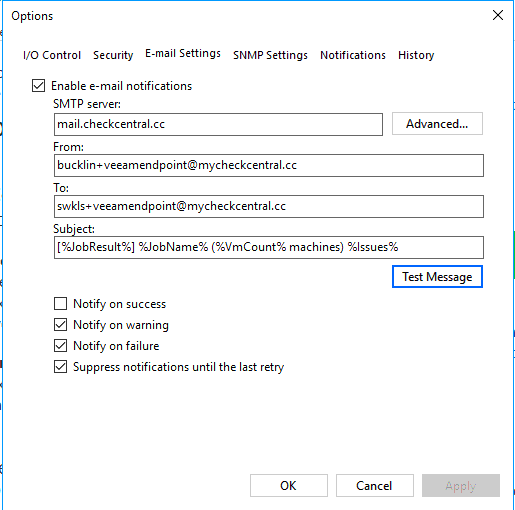Veeam: Difference between revisions
Jump to navigation
Jump to search
No edit summary |
No edit summary |
||
| Line 1: | Line 1: | ||
==Warnings Due To VM Config Version== | ==Warnings Due To VM Config Version== | ||
Reference:https://docs.microsoft.com/en-us/windows-server/virtualization/hyper-v/deploy/upgrade-virtual-machine-version-in-hyper-v-on-windows-or-windows-server | <blockquote style="background:#f2f2f2;border-left:5px solid #428bca;padding:12px;margin:0px;>Reference:https://docs.microsoft.com/en-us/windows-server/virtualization/hyper-v/deploy/upgrade-virtual-machine-version-in-hyper-v-on-windows-or-windows-server</blockquote> | ||
===Step 1: Check the virtual machine configuration versions=== | ===Step 1: Check the virtual machine configuration versions=== | ||
| Line 12: | Line 12: | ||
===Step 2: Upgrade the virtual machine configuration version=== | ===Step 2: Upgrade the virtual machine configuration version=== | ||
Shut down the virtual machine in Hyper-V Manager. | # Shut down the virtual machine in Hyper-V Manager. | ||
Select Action > Upgrade Configuration Version. If this option isn't available for the virtual machine, then it's already at the highest configuration version supported by the Hyper-V host. | # Select Action > Upgrade Configuration Version. If this option isn't available for the virtual machine, then it's already at the highest configuration version supported by the Hyper-V host. | ||
To upgrade the virtual machine configuration version by using Windows PowerShell, use the Update-VMVersion cmdlet. Run the following command where vmname is the name of the virtual machine. | To upgrade the virtual machine configuration version by using Windows PowerShell, use the Update-VMVersion cmdlet. Run the following command where vmname is the name of the virtual machine. | ||
<syntaxhighlight lang="powershell" line start="1"> | <syntaxhighlight lang="powershell" line start="1"> | ||
Revision as of 22:02, 27 March 2020
Warnings Due To VM Config Version
Step 1: Check the virtual machine configuration versions
- On the Windows desktop, click the Start button and type any part of the name Windows PowerShell.
- Right-click Windows PowerShell and select Run as Administrator.
- Use the Get-VMcmdlet. Run the following command to get the versions of your virtual machines.
Get-VM * | Format-Table Name, Version
You can also see the configuration version in Hyper-V Manager by selecting the virtual machine and looking at the Summary tab.
Step 2: Upgrade the virtual machine configuration version
- Shut down the virtual machine in Hyper-V Manager.
- Select Action > Upgrade Configuration Version. If this option isn't available for the virtual machine, then it's already at the highest configuration version supported by the Hyper-V host.
To upgrade the virtual machine configuration version by using Windows PowerShell, use the Update-VMVersion cmdlet. Run the following command where vmname is the name of the virtual machine.
Update-VMVersion <vmname>
Supported virtual machine configuration versions
Run the PowerShell cmdlet Get-VMHostSupportedVersion to see what virtual machine configuration versions your Hyper-V Host supports. When you create a virtual machine, it's created with the default configuration version. To see what the default is, run the following command.
Get-VMHostSupportedVersion -Default
